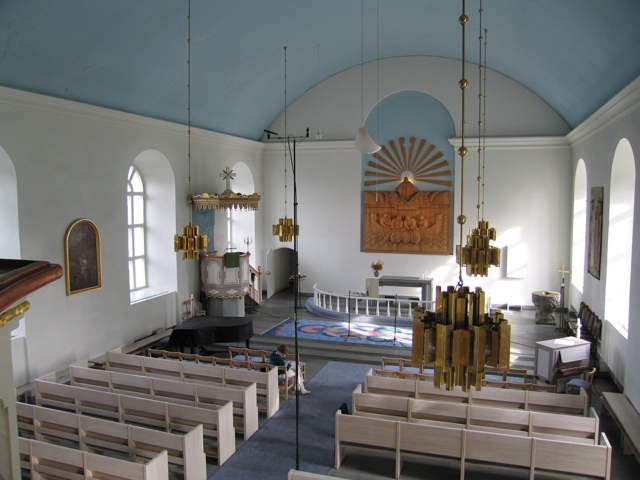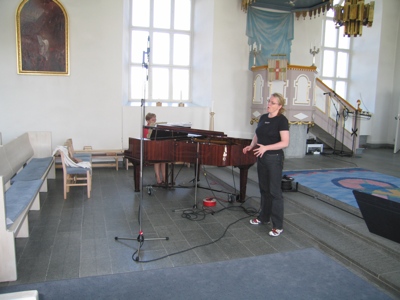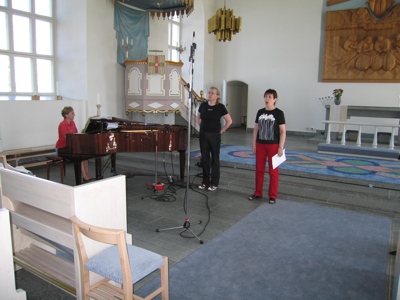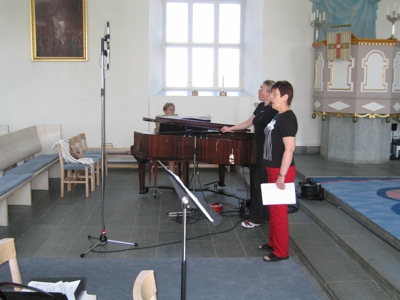Dear experts,
I've been asked to document a recital with an alto, a soprano and piano in this church:

The room is smallish (26 x 12 m), walls and floor stone. The room is lively, but far from cathedral like. RT is perhaps 3-4s. The piano is the one on the picture. Most likely they intend to sing from the stairs in the center of the church at the end of the aisle. Alternating solo alto, solo soprano, duett. Piano for all songs.
I've got mikes to do all the coincidence, near coincidence and A/B stereo setups or one per performer. In a room like the pictured, where would you start? How would you deal with the piano? They will probably want the lid closed (from past unrecorded experience). They might move the piano in towards the center, but not up the stairs. Mics on the piano? or just a main pair? One mic per singer or a stereo pair?
I'll be at their rehearsal on tuesday. Recital on wednesday evening.
How would you approach this?
best regards
Lars

Comments
Hmmm, difficult acoustic for a recital. I would use as dry a mi
Hmmm, difficult acoustic for a recital.
I would use as dry a mic technique as possible, cross cardioids ORTF as main pair (or MK21 if you have similar) or MS, and a some cardioid or super cardioid spots on the singers, and the piano just in case, you may not need them. Move the piano into the middle or as near to the middle as possible. Piano on half stick or full stick if possible, never have the piano lid closed, it sounds really boring.
Can the singers stand in front of the piano? If not due to space restrictions, then the piano will have to remain at the side, and will definitely need a cardioid spot on it.
Start balancing with the main pair. Not too high, 7 or 8ft in the air. Bring in the spots as needed. You are trying to get as dry a sound as possible, since the room is so wet.
It also depends on the music being performed as well. Is it religious music written for a wet acoustic or is it lieder where you need intimate and dry.
Difficult recording, good luck with it.
PS. Make sure piano is well tuned, VERY important.
Thank you! DavidSpearritt wrote: Hmmm, difficult acoustic for a
Thank you!
This is fairly representative of the churches around here. Not the worst by far. It's always a bit scary to listen to what I actually got the day after on speakers. It's usually wetter than I expected it to be, but I'm learning (at least trying to)...
Spring finally here, no special christian holiday (I don't think) so I expect the program to lean towards lieder and operatic content. I'll learn on the rehearsal on tuesday.
best regards
Lars
YOu have received excellent advice from David. ORTF all the way.
YOu have received excellent advice from David.
ORTF all the way. . .
Thanks David and Plush for sharing your experience. I feel more
Thanks David and Plush for sharing your experience. I feel more confident now.
I'll think this leads me to start with a (near) coincident pair in the aisle. Near enough to make it dryish and far away enough to not freak them out and also, there is visuals to consider. It's a recital first and foremost after all.
Then there's the piano. I can probably persuade them to move it towards the center, but I suspect they will be more or less in line left to right - piano, singer, singer. Well see tomorrow. Maybe open lid or maybe not. I have some idea of how to record piano as a solo instrument, but that is at least 1m (3-4') away from the bend of an open piano, looking in, but...
- How does one spot mic a piano when the main pair is elsewhere?
- How does one spot mic a piano with the lid closed (if that's their choice)?
best regards
- How does one spot mic a piano when the main pair is elsewhere?
Lid open, no problem. An SDC in the usual place, back from the hammers. You may not need so much bass if the main pair is good at low frequencies. Remember to delay the spot mic by 5 - 10ms so the phasing is right relative to the mains. Pan the spot into the mix where the mains say it should be.
Lid closed - real problems spot miking. You did want it to sound like baked bean cans rattling round inside a coffin, didn't you? You are almost better off without a spot mic and move the main mics off-centre until you get the best sound from them.
I would have thought you would need the lid open to get proper live sound projection into the audience in a building like that.
I disagree about the lid open spot placement suggestion, I would
I disagree about the lid open spot placement suggestion, I would put the mic near the tail pointing toward the pianist, so that the singers are in the null, and the distance from the middle of the soundboard is still about .75-1m or so away. Hammers don't make the sound, the soundboard does.
Listen carefully and pan the spot to the left so that the piano position doesn't jump around between the main pair on its own and with the spot mixed in. If the piano is on half stick, then place the mic low still looking in through the opening, but still in the same position near the tail. This is a lieder recital, you do not want a jazz piano sound. Mix the spot so that you can barely perceive it in the main pr mix, to give definition but no more.
If the lid is closed then the best place for the spot is underneath the piano, say 1 ft above the floor looking up at the underside of the soundboard, you know, the bit that is making the nice sound. Similar position as before to keep the singers in the spot mic null.
The mention of the hammers was not that they made the sound but
The mention of the hammers was not that they made the sound but they were an identifiable geographical reference point. In my experience, miking the tail of the instrument gives a pleasant but bass-heavy result, since the higher strings finish well short of the tail. Depending on what the main stereo pair is capturing of the piano sound, this may or may not be what you want. One advantage of using a spot mic for the piano when recording a lieder recital, as opposed to using a stereo pair to record a piano recital, is that it is mono, and is thus easier to position for a sound that complements that captured by the main pair.
By contrast, a grand piano with its lid shut is very difficult to record so that it sounds like the same instrument. An external spot microphone positioned almost anywhere close tends to emphasise the vibrations of whatever part of the instrument it is nearest, be that the sounding board or the rest of the case. Just as in a string instrument, what we hear when we listen to a piano is a combination of all the different bits of the instrument speaking, and the sounding board, while itself speaking the loudest, is a way of coupling the energy of the vibrating strings into the whole body.
Thanks again for all your advise. I thought it could be interest
Thanks again for all your advise. I thought it could be interesting to report back from the rehearsal.



First a couple of pictures.
Piano on full stick was rejected for two reasons. Loudness and loudness. The first in the balance with the voices and the second because it disturbed the soprano in that she was "tricked" into singing louder than wanted by having a loud source near. Half seemed OK. Their voices fills the room with ease.
They moved about rather a lot (and I followed with the mics:-) and finally settled on the placement in the pictures. We'll see if that remains true tomorrow... There is (at least) one problem that I think will be left unsolved. The alto intends to sing one of the songs in the aisle, walking all the way to the back of the church and back again.
This is what the pictures above sound like. Pleas suggest changes that can improve.
The sound files will be up for a while and then removed.
Both singing (Purcell: Lost is my quiet)
http://www.farm.se/bild/20060509_rep/purcell.mp3
Alto singing: (Nyström: Havets visa)
first mixed XY + spots on piano
http://www.farm.se/bild/20060509_rep/nystrom.mp3
same, only XY
http://www.farm.se/bild/20060509_rep/nystrom_xy.mp3
same, only piano (omnis looking in under the lid towards the lower end)
http://www.farm.se/bild/20060509_rep/nystrom_piano.mp3
Both the XY and piano are at their relative levels in the mix (the piano about -10dB (whatever that means when they're not normalised))
best regards
Lars
Lars, Thanks for the informative post. The photos are great al
Lars,
Thanks for the informative post. The photos are great along with the samples. I listened on phones, so this isn't the last word...
I didn't find the addition of the piano spots to be a clear win to me. While it might be a little richer sounding, I like the clarity of the XY only. Did you use spaced Omni's for the spot? If so, you might consider using only one. Perhaps that will let you get the balance you want without losing as much clarity.
Regarding the left-to-right image... you have (it seems) captured the reality of the situation, but I think this might be troublesome in listening to the recording without having been there to understand the setup. You might try to move the main array a bit to the right and point it left to get the singers and the piano better balanced in the image. A few feet might be enough to do it.
I have a similar problem in a recording coming up tonight, but for slightly different reasons. It's a flute-piano duet, but the place we are recording has an upright. It's a very nice sounding instrument (I've recorded it before), but the performers need sight lines to perform and that makes it hard to position the flute to give a nice spatial rendering vs. the piano. I'll post some photos and samples afterward - I'm sure I'll need advice on that one!
Michael
Boswell wrote: Just as in a string instrument, what we hear when
Sorry to be argumentative, but this is incorrect. In a piano nothing else sounds to any significance except the soundboard. Piano makers go to great pains to structurally and acoustically DE-COUPLE the soundboard from the frame and do it very successfully. They also make the other bits very massive and stiff, partly to support the frame and huge tensions from the strings, but also, significantly, to make sure they don't make any sound of their own for obvious reasons.
The statement is incorrect for other stringed instruments as well for the same reasons.
A little O.T., but I love the appearence of mahogany pianos. .
A little O.T., but I love the appearence of mahogany pianos.
... will have to listen to the clips.